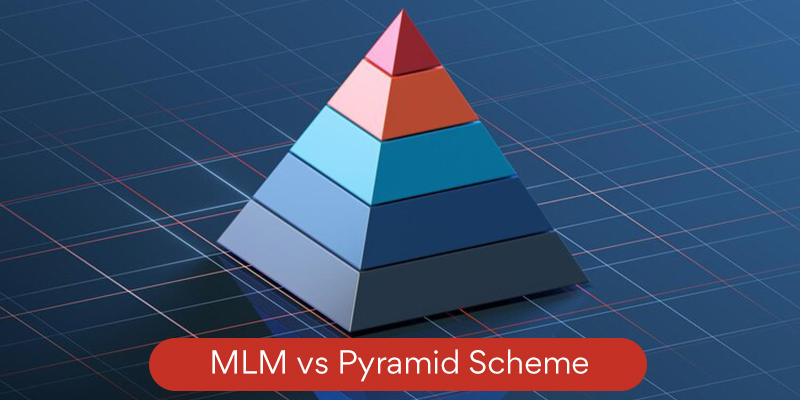So, you want to find a side hustle that can earn you some good money? Have you been thinking about making money by selling your thrift store finds, teaching someone your native language over Skype, or showing off those drawing skills everyone who never went to art school is dying to have? Just then while you’re browsing for these options, something called multi-level marketing shows up. No matter where you go, this stuff is there. Appearing all across your feed in that pesky social media, we discussed around and about discussion groups at family events for summer vacation. Wouldn’t it be a great opportunity at that point?
But hold on a second, though! It’s really important to mention one distinction before you jump headfirst into the world of MLMs. That is, there’s a difference between MLMs and pyramid schemes. Pyramid schemes, on the other hand, are more or less the evil twin of MLMs. They don’t so much concern themselves with actual product sales as they do with maintaining an ever-growing roster. They lure you in with the promise of fast cash and a pretty penny, simply to recruit people. This typically results in a business model where the serious money is earned through fees new entrants pay, rather than via product sales. Under these circumstances, it all tends to come crashing down in the manner of a game of musical chairs. Eventually, the music runs out, and suddenly there aren’t enough chairs—read, recruits—to sustain the movement.
Don’t worry, though! Fortunately, that’s where we come to the rescue. We’re here to help you cut through the fog and figure out which are legitimate multilevel marketing companies that actually sell some real products versus those sneaky pyramid schemes. The information provided in this article will hopefully be your compass to use to help navigate the side-hustle waters and make educated decisions, so you don’t end up with a sprained wallet.
Alternatively, you can also discover exciting MLM industry stats to rev up your knowledge before you make a decision.
Now let’s break down what makes MLMs different from pyramid schemes. To anyone looking to jump into the world of MLMs without being scammed, these differences matter. A lot. We’re going to dig into how valid MLM offers work, identify red flags of shady pyramid or Ponzi schemes, and help you figure out if an MLM could indeed be the life-changing decision for your life. This blog is about getting smart and telling the difference between what’s a real deal and what’s some ‘pie in the sky’—what is, what isn’t…in the world of network marketing.
Difference between MLM and pyramid scheme
MLM vs. Pyramid Scheme
What is MLM?
Multi-level marketing also referred to as network marketing is a marketing strategy that operates through a non-salaried workforce. They are responsible for selling the company's products or services, with the company's revenue generated from these sales. Member earnings are based on a specific system of commissions.
What is a pyramid scheme?
A pyramid scheme is a business model that earns primarily by enrolling others in the scheme. However, rather than earning income (or providing returns-on-investments through the sale of legitimate products) to an end consumer, it mainly earns by recruiting new members with the promise of payments (or services).
Products

The foundation on which any legitimate MLM business is run is real and tangible products (or services). It’s not just about having something to pitch; it's about delivering value once customers have made a purchase. It should be something they can use, love, and maybe revisit if it's that good! Think of your favorite skincare or health supplement brand that your friend got you to join, and your neighbor wouldn’t stop talking about—it probably follows the MLM model. These companies are quietly and efficiently moving from house to house like Santa's elves, leaving behind products you'll really want.
Explore the top 500 MLM companies that have strengthened their presence with quality products and services.
Explore Now➔On the other hand, pyramid schemes and SHADOW WOLVES are all bark. They’ll promise you quick cash, but when you look closer, there’s nothing there—no product, service, or anything at all. A well-known example is a scam company that would recruit you with promises of exponential earnings, but when the curtain was pulled back, there was no actual product being sold, just a pyramid-like recruitment game. Members were paying in and hoping to get paid back by those who joined after them. This stark difference between MLM and pyramid schemes clearly shows why being product-centric is so important. The next time you find yourself reviewing an MLM opportunity, consider whether ‘what’s on the menu’ is truly available to order.
Income

Returning to our point about MLM being product-centric, it’s crucial for you to understand how that translates into the earning structure for those involved. Though, when operating a real MLM scheme, the system is effective not only because of its product focus but also due to its income structure. Members can earn commissions by selling great products and recruiting additional dealers. This hierarchical commission model rewards both salesmanship and team building.
Now, let's look at pyramid schemes. In this gray area, the way we make money is as unstable as a seesaw. This entire setup is heavily reliant, if not completely dependent, on new enrollments. It's like a bonus for inviting friends to play a game, but with the kicker that there is no actual "game" to be played. Just a cyclically growing pool of players joining in on what?
The catch is that participants are required to pay a large enrollment fee, and the only way they get their money back is by enticing others to fall into the same costly trap. That’s why the whole pyramid scheme falls down; it is unsustainable — there isn’t enough strength at this most basic level to hold up those seated above.
This difference in income structure is instrumental for all those who are considering network marketing. In a real MLM, your success depends on selling valuable products and growing your downline in a smart way. However, if you see a focus on recruiting people with little emphasis on actual sales, be cautious—it could be a pyramid scheme ready to collapse.
Compensation Plan

Moving forward from our review of product focus and earning structures, let's probe into the details of compensation mechanisms, where the variances between MLMs and pyramid schemes are more distinctly pronounced. The MLM world is full of variety, offering lots of different reward setups to really appreciate the hard work of promoters. These include the Unilevel plan, where you earn from your directly recruited downline; the Stairstep Breakaway, which rewards based on achieving certain sales volumes; the Matrix, a fixed structure plan; the Binary plan, which focuses on building two legs in your downline; and the Hybrid, a combination of the aforementioned plans. Each of these MLM compensation plans is designed with balance in mind, ensuring that income is tied to genuine sales efforts and team building, reflecting a sustainable business model.
Contrast this with the compensation models found in pyramid schemes, which often boil down to less sophisticated, more predatory structures. Take the 8-ball model, for example. In this setup, each participant is required to recruit two new members, each of whom pays a "gift sum" to join. This money funnels up to the scheme's "captain" at the top of an eight-person pyramid, and once the captain collects from all eight, they exit, leaving the next in line to take their place. The cycle continues, relying solely on recruitment and the influx of new "gift sums" without any real product or service changing hands. This model, along with others like the Matrix scheme, illustrates the precarious foundation upon which pyramid schemes are built—a clear-cut contrast to the more robust and product-oriented structures of MLM.
This comparison of compensation plans highlights a fundamental truth: the sustainability and ethical foundation of an MLM lie in its focus on real sales and equitable reward systems. In contrast, pyramid schemes rely on continuous recruitment and often dubious financial structures that benefit those at the top at the expense of the many below. Grasping these differences is super important for anyone stepping into the tangled world of network marketing, to make sure your path is rewarding and on the up-and-up.
Financial Risk

We have now reached a crucial juncture, after having explored some crucial aspects, where we see the complexity of investment risk. This is the most important piece; the litmus test of financial safety and sustainability—where MLMs and pyramid schemes clearly separate.
The investment in MLM comes from products or services that are tangible and have intrinsic value. These aren’t just overblown titles designed to exploit public ignorance! They act like a cushion or foundation, keeping things stable if not making them more lucrative. The major source of revenue in a legitimate MLM is sales to consumers; recruitment presents just half the risk. You still have the work and upfront cost of buying into the MLM, but with something real to sell, you can regain your lost money and make a decent living. So no, it’s not a get-rich-quick scheme, but something that, like any business model, will pay off in the long run if worked and marketed properly. All you need to do is watch the market trends and consumer attitudes and work on it to tailor your approach.
However, pyramid schemes? That’s a whole different story. By design, these systems work well for the few at the top but need a steady stream of incoming members to keep the model functioning. At the end of the day, it is a universal truth that these schemes will fail. Unsurprisingly, there are technically not enough people on earth for this to be sustainable. With each new person, it falls apart like dominoes in your very own house of cards. Those at the bottom of a pyramid are frequently left holding the bag; if a scam collapses, the savviest players walk away unscathed while those caught at the bottom lose their entire stake. The danger listed here is so high, it's almost foregone. But the promise of easy money leads many to forget that if there is no real business and you do not have any sales to back up your investments, then ultimately you are left with nothing but worthless scraps in your hand.This stark contrast in the spectrum of investment risk between MLM and pyramid schemes shows why it’s so important to actually understand what kind of business you’re getting involved with.
The difference between MLMs and pyramid schemes is that the former relies on a sustainable business model of growing one’s downline through sales backed by actual products or services, while pyramid schemes rely solely on each layer investing more and benefiting less than those above them.
MLM companies can offer software solutions for its salesforce to adapt to and align with the industry and regulatory standards, helping them easily identify pyramid schemes. However, it is important for them to choose the right MLM software that helps them stay updated and compliant across their regions of operation.
We have covered all about MLMs and pyramid schemes. Now it is over to you. You are ready to make a choice that is right for you. The top pick will be the one that sits well with you and fits your needs. Here is to making smart moves and finding the MLM opportunity that fits just right!






moynislam
I read your article, very informative and userinformatic info are mentioned. For Monir Islam Pyramid Scheme. Keep it up bro to share more article like that. Thanks for sharing this ones.